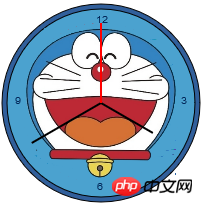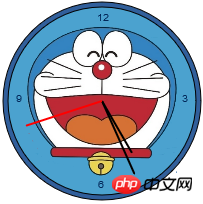Code for using canvas to draw 'Doraemon' clock
This article mainly introduces the JavaScript learning summary and related information on using canvas to draw the "Doraemon" clock. Friends who need it can refer to it
Foreword: I finished reading the canvas canvas of the JS book today. Zhang, I’m so happy~ It’s my beloved canvas again~ Oye~
I saw someone suggested that I draw Fatty Blue before, yes, why did I forget my favorite Fatty Blue in childhood, in order to express my love for Blue Fatty’s apology, so I drew a moving hello world today, which is considered a kind of progress~
Okay everyone, passengers who are getting on the bus, please go inside, and please don’t block the passage, thank you. Let’s drive~
Text:
Let’s take a picture today and see the effect

Today’s Fat Blue looks like this, I was relieved to see that it was still so fat. This world is still full of positive energy, and there are always people who are fatter than me, hahaha
Then comes the code
#html part
<canvas id="myCanvas" width="500" height="500">快去升级浏览器吧~</canvas>
Js part
window.addEventListener("load", function(){
//获取画布上下文
var context = document.getElementById("myCanvas").getContext("2d");
//判断上下文是否存在,存在则可以执行接下来的代码
if(context){
//开始一个新的子路径
context.beginPath();
//我们准备画两个同心圆作为时钟的边框
//画一个外面的大圆
context.arc(100,100,99,0,2*Math.PI,false);
//以某种很好看的蓝色填充
context.fillStyle = "#315f9b";
context.fill();
//画大圆的边线
context.stroke();
//开始一条新的子路径,
//此处是必须的,要不然之后填充的颜色会把之前的全部覆盖
context.beginPath();
//将开始点移动到(194,100),用半径和圆心计算得出的点
context.moveTo(194,100);
//画内部的小圆(圆神?)
context.arc(100,100,94,0,2*Math.PI,false);
//用另一种很好看的稍浅蓝色填充内部小圆
context.fillStyle = "#4ba2cf";
context.fill();
context.stroke();
//蓝胖子出现啦~
//创建一个Image对象,将它的src设置为蓝胖子的图片
var image = new Image();
image.src = "2.png";
//用上下文的方法drawImage将图片从点(25,25)开始画,画在边长150的矩形中
context.drawImage(image,25,25,150,150);
//移动变换矩阵
//移动后(100,100)作为新的原点,即(0,0)
context.translate(100,100);
//用一个同样很好看的蓝色来画我们的时间点
context.fillStyle = "#02285a";
//fillText第一个参数为要画的字符串,第二个参数为x,第三为y
//以下x,y值是调试后的效果,大家根据不同情况,再做调整哦
context.fillText("12",-5,-80);
context.fillText("6",-4,87);
context.fillText("3",80,1);
context.fillText("9",-86,1);
//稍候详述此函数
nowTime(context);
}
},false);The dials of the above clocks all appear, but the reason why the clock is The most important thing about a clock is that it can display time (nonsense), so the next step is to draw the pointer
nowTime function part
function nowTime(context){
//创建一个日期对象,用来获取本地的时间
var myDate = new Date();
//获取小时,分钟,秒钟
var myHour = myDate.getHours();
//将小时转换为12时制
if(myHour >= 12){
myHour = myHour-12;
}
var myMin = myDate.getMinutes();
var mySec = myDate.getSeconds();
//描绘小时
//用来存放当前小时在表盘上的弧度
var hourArc;
//以3时作为圆周的起点,顺时针表示弧度
if(myHour < 3){
hourArc = 2*Math.PI-(3-myHour)*Math.PI/6;
}else{
hourArc = (myHour-3)*Math.PI/6;
}
//当指向3,6,9,12时,正好为90°的倍数
//此处因为角度转换为弧度有偏差,所以特别处理下
switch(myHour){
case 0:
hourArc = Math.PI*3/2;break;
case 3:
hourArc = 0;break;
case 6:
hourArc = Math.PI/2;break;
case 9:
hourArc = Math.PI;break;
}
//调用drawTime函数,在表盘上画出小时针
drawTime(context,hourArc,60);
//描绘分钟
//用来存放当前分钟在表盘上的弧度
var minArc;
//以15分作为圆周的起点,顺时针表示弧度
if(myMin < 15){
minArc = 2*Math.PI-(15-myMin)*Math.PI/30;
}else{
minArc = (myMin-15)*Math.PI/30;
}
//处理分钟,依然是此处因为角度转换为弧度有偏差,所以特别处理下
switch(myMin){
case 0:
minArc = Math.PI*3/2;break;
case 15:
minArc = 0;break;
case 30:
minArc = Math.PI/2;break;
case 45:
minArc = Math.PI;break;
}
//调用drawTime函数,在表盘上画出分钟针
drawTime(context,minArc,80);
//描绘秒钟
//用来存放当前秒钟在表盘上的弧度
var secArc;
//以15秒作为圆周的起点,顺时针表示弧度
if(mySec < 15){
secArc = 2*Math.PI-(15-mySec)*Math.PI/30;
}else{
secArc = (mySec-15)*Math.PI/30;
}
//处理秒钟,依然依然此处因为角度转换为弧度有偏差,所以特别处理下
switch(mySec){
case 0:
secArc = Math.PI*3/2;break;
case 14:
secArc = 0;break;
case 29:
secArc = Math.PI/2;break;
case 44:
secArc = Math.PI;break;
}
//调用drawTime函数,在表盘上画出小时针
drawTime(context,secArc,80,"red");
//设置一个超时调用函数,每一秒超时调用nowTime更新时钟
setTimeout(function(){
//调用画新的指针前,当然应该要清除下原来的时针吧,用clearTime函数,真的好用!
clearTime(context);
//把闲杂指针清除了,再画一次当前的指针吧~
nowTime(context);
},1000);
}So, how do we operate the context to draw the pointer? I don’t know either, so let’s end it here today~
Just kidding, hehe, take it easy (you must pretend to be tricked by me)
The next step is the drawTime function , it has a total of four parameters (context, theArc, theLength, color="#000"). Context is the context of the canvas at a glance, theArc is the angle we want to rotate the canvas, theLength represents the length of the pointer, and color is the pointer. s color.
function drawTime(context,theArc,theLength,color="#000"){
//保存当前的画布环境,和restore方法配合使用能够恢复画布上下文
context.save();
//旋转画布,rotate传入的参数代表旋转的弧度
context.rotate(theArc);
//开始一条新的子路径,我们开始画指针啦
context.beginPath();
//将开始点移动到(0,0)
context.moveTo(0,0);
//画一条到(theLength,0)的路径
context.lineTo(theLength,0);
//用指定的color颜色画这条路径
context.strokeStyle = color;
//路径的宽度为2
context.lineWidth = 2;
//路径是不可见的,如果要看到路径,需要用stroke来描线,而如何描这条线,可以由我们以上用到的几个属性来定义
context.stroke();
//恢复上下文
context.restore();
}Although it’s coming to an end, there is still a very important clearTime function. Without it, your clock will be occupied by dense second hands, love. Trypophobia patients, we are all responsible Lovely programmers, please remember to eat~
The above is the entire content of this article. I hope it will be helpful to everyone’s study. For more related content, please pay attention to the PHP Chinese website ! Related recommendations:
Code to draw smiling faces using Canvas in HTML5
HTML5 and CSS3 code to implement 3D display of product information
The above is the detailed content of Code for using canvas to draw 'Doraemon' clock. For more information, please follow other related articles on the PHP Chinese website!

Hot AI Tools

Undresser.AI Undress
AI-powered app for creating realistic nude photos

AI Clothes Remover
Online AI tool for removing clothes from photos.

Undress AI Tool
Undress images for free

Clothoff.io
AI clothes remover

AI Hentai Generator
Generate AI Hentai for free.

Hot Article

Hot Tools

Notepad++7.3.1
Easy-to-use and free code editor

SublimeText3 Chinese version
Chinese version, very easy to use

Zend Studio 13.0.1
Powerful PHP integrated development environment

Dreamweaver CS6
Visual web development tools

SublimeText3 Mac version
God-level code editing software (SublimeText3)

Hot Topics
 1386
1386
 52
52
 Which schools use canvas?
Aug 18, 2023 pm 05:59 PM
Which schools use canvas?
Aug 18, 2023 pm 05:59 PM
Schools using canvas include Stanford University, MIT, Columbia University, University of California, Berkeley, etc. Detailed introduction: 1. Stanford University uses Canvas as its main online learning platform. Teachers and students at Stanford University use Canvas to manage and communicate course content, and learn through functions such as online discussions, assignment submissions, and exams; 2. Ma Provincial Polytechnic Institute and MIT also use Canvas as their online learning management system and conduct course management through the Canvas platform; 3. Columbia University, etc.
 What are the canvas arrow plug-ins?
Aug 21, 2023 pm 02:14 PM
What are the canvas arrow plug-ins?
Aug 21, 2023 pm 02:14 PM
The canvas arrow plug-ins include: 1. Fabric.js, which has a simple and easy-to-use API and can create custom arrow effects; 2. Konva.js, which provides the function of drawing arrows and can create various arrow styles; 3. Pixi.js , which provides rich graphics processing functions and can achieve various arrow effects; 4. Two.js, which can easily create and control arrow styles and animations; 5. Arrow.js, which can create various arrow effects; 6. Rough .js, you can create hand-drawn arrows, etc.
 What are the details of the canvas clock?
Aug 21, 2023 pm 05:07 PM
What are the details of the canvas clock?
Aug 21, 2023 pm 05:07 PM
The details of the canvas clock include clock appearance, tick marks, digital clock, hour, minute and second hands, center point, animation effects, other styles, etc. Detailed introduction: 1. Clock appearance, you can use Canvas to draw a circular dial as the appearance of the clock, and you can set the size, color, border and other styles of the dial; 2. Scale lines, draw scale lines on the dial to represent hours or minutes. Position; 3. Digital clock, you can draw a digital clock on the dial to indicate the current hour and minute; 4. Hour hand, minute hand, second hand, etc.
 What versions of html2canvas are there?
Aug 22, 2023 pm 05:58 PM
What versions of html2canvas are there?
Aug 22, 2023 pm 05:58 PM
The versions of html2canvas include html2canvas v0.x, html2canvas v1.x, etc. Detailed introduction: 1. html2canvas v0.x, which is an early version of html2canvas. The latest stable version is v0.5.0-alpha1. It is a mature version that has been widely used and verified in many projects; 2. html2canvas v1.x, this is a new version of html2canvas.
 Learn the canvas framework and explain the commonly used canvas framework in detail
Jan 17, 2024 am 11:03 AM
Learn the canvas framework and explain the commonly used canvas framework in detail
Jan 17, 2024 am 11:03 AM
Explore the Canvas framework: To understand what are the commonly used Canvas frameworks, specific code examples are required. Introduction: Canvas is a drawing API provided in HTML5, through which we can achieve rich graphics and animation effects. In order to improve the efficiency and convenience of drawing, many developers have developed different Canvas frameworks. This article will introduce some commonly used Canvas frameworks and provide specific code examples to help readers gain a deeper understanding of how to use these frameworks. 1. EaselJS framework Ea
 uniapp implements how to use canvas to draw charts and animation effects
Oct 18, 2023 am 10:42 AM
uniapp implements how to use canvas to draw charts and animation effects
Oct 18, 2023 am 10:42 AM
How to use canvas to draw charts and animation effects in uniapp requires specific code examples 1. Introduction With the popularity of mobile devices, more and more applications need to display various charts and animation effects on the mobile terminal. As a cross-platform development framework based on Vue.js, uniapp provides the ability to use canvas to draw charts and animation effects. This article will introduce how uniapp uses canvas to achieve chart and animation effects, and give specific code examples. 2. canvas
 What properties does tkinter canvas have?
Aug 21, 2023 pm 05:46 PM
What properties does tkinter canvas have?
Aug 21, 2023 pm 05:46 PM
The tkinter canvas attributes include bg, bd, relief, width, height, cursor, highlightbackground, highlightcolor, highlightthickness, insertbackground, insertwidth, selectbackground, selectforeground, xscrollcommand attributes, etc. Detailed introduction
 Explore the powerful role and application of canvas in game development
Jan 17, 2024 am 11:00 AM
Explore the powerful role and application of canvas in game development
Jan 17, 2024 am 11:00 AM
Understand the power and application of canvas in game development Overview: With the rapid development of Internet technology, web games are becoming more and more popular among players. As an important part of web game development, canvas technology has gradually emerged in game development, showing its powerful power and application. This article will introduce the potential of canvas in game development and demonstrate its application through specific code examples. 1. Introduction to canvas technology Canvas is a new element in HTML5, which allows us to use




